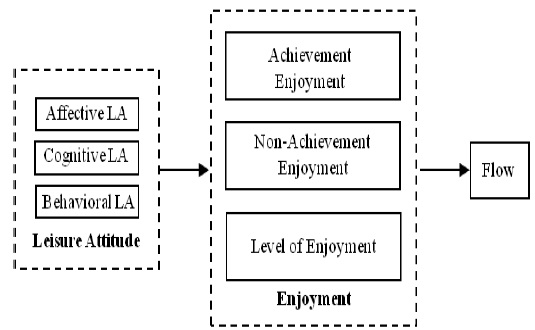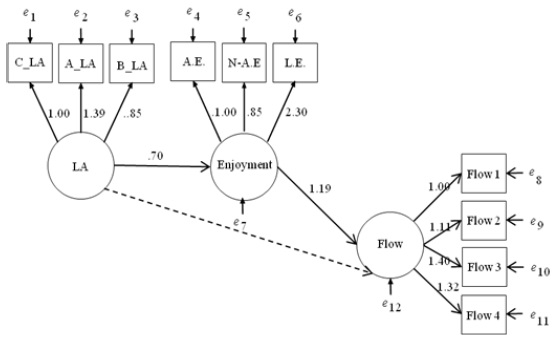


본 연구의 목적은 두 가지로 나누어진다. 첫 번째 목적은 여가 태도, 즐거움, 몰입 요인간의 관계를 이해하는 것이고 두 번째 목적은 제시한 세 가지 요인들을 바탕으로 체육관련 여가활동에 대한 개념적 모델을 제시하는 것이다. 본 연구 결과에 따르면, 감성적 여가 태도는 성취감 즐거움, 비성취감 즐거움, 몰입에 모두 긍정적인 영향을 미치는 것으로 나타났다. 인지적 여가 태도는 성취감 즐거움에만 긍정적인 영향을 미쳤으며, 행동적 여가태도는 즐거움과 몰입에 유의한 관계를 나타내지 않았다. 일반적 즐거움은 감성적 여가태도에 의해 긍정적인 영향을 받으며, 성취감 즐거움과 비성취감 즐거움 그리고 일반적 즐거움은 몰입과 긍정적인 관계를 가진다. 구조방적식 모형에 의하면 이 연구에서 제시한 모형 적합도 지수는 보통 혹은 적합한 것으로 나타났으며, 이모형을 통하여 여가태도, 즐거움, 몰입에 대한 관계가 설명되어졌다.
This study aims were twofold: to understand the relationships between Leisure Attitude (LA), flow, and enjoyment and to test a conceptual map in the order LA, enjoyment, and flow, illustrated in <Figure 1>.
The relationships were examined in Physical Leisure Activity(PLA) contexts because PLA benefits have been endorsed throughout broad research(McNeely, Campbell, Rowe, Klassen, Mackey, & Courneya, 2006; Walker & Virden, 2005). Previous studies showed that PLA is a feasible means of health promotion, stress relief, and disease prevention(Walker & Virden, 2005), and it helps to improve functional and physical well-being(McNeely et al., 2006). Despite of this, a number of people not engaging any PLA has increased, and adult obesity rates have soared in recent decades(Trudeau & Shephard, 2005). For example, in the United States, in 2009, adult obesity rates raised in 28 states, and 38 states had adult obesity rates over 25%, a considerable and significant increase since 1991(Hogan, Segal, & Levine, 2010). The increases of obesity rates and sedentary behaviors are not exceptional in Korea despite the fact that physical leisure activity is a top preference of Koreans’ leisure activities(Kim, 2001). According to Statistics Korea (2013), in 2012, 66.7% of young adults (from 13 to 24 years old) did not participate in regular physical activities, and 14.7% of students in elementary, middle, and high schools had obesity. In considering both the benefits of PLA and a dearth of PLA current school age people and adults are exercising, we seeks to find ways to promote PLA by examining LA, enjoyment, and flow.
To address the relationships, reasoned theoretical associations among the variables are provided because little existing statistical models can “prove” causality. Statistical applications only can show the associations between variables and strengthen the soundness of the causal relationships but do not provide any means to “prove” the causal relationships (Hayes, Preacher, & Myers, 2011). Causality is only built by logical and theoretical argument; it is pertinent to provide a summary of previous research on each psychological variable. Thus, what follows is a brief review of literature regarding flow, LA, and enjoyment.
Since Csikszentmihalyi(1975) introduced flow to social and psychological studies, it has been studied in various contexts(Jackson, Thomas, Marsh, & Smethurst, 2001). Studies showed that people feel happiness and satisfaction by experiencing flow, and Csikszentmihalyi(1990) claimed that “whenever the goal is to improve the quality of life, then flow can point the way”(p. 5). He also stated that flow is a basis of optimal experience in which “people are so involved in an activity that nothing else seems to matter; the experience itself is so enjoyable that people will do it even at great cost, for the sheer sake of doing it” (p. 4). The benefits and importance of flow are documented, and an profound understanding of flow is promising to provide quality leisure programs. However, a literature review study showed little published research concurrently addressing the relationships of LA, enjoyment, and flow. Therefore, this study aims to explore how people more readily experience flow from experiencing LA and enjoyment. In the following, the importance of LA and enjoyment in PLA contexts and the associations among LA, enjoyment, and flow are discussed.
Leisure Attitude(LA) is defined as one’s attitude toward leisure or one’s particular way of thinking about, feeling about, and acting toward leisure(Neulinger, 1981). LA consists of three dimensions; a)affective, b)cognitive, and c)behavioral aspect(Ragheb, 1980). An attitude and belief regarding a specific object are formed by social/situational influences as well as by personal experiences during the time mostly from childhood to adolescence(Austin & Austin, 1983). Once LA is shaped, it does not easily change, as stated that attitude is “a learned predisposition to respond in a consistently favorable or unfavorable manner with respect to a given object”(emphasis added)(Fishbein & Ajzen, 1975). As children become adults, childhood salient beliefs about their leisure activity become general beliefs about leisure activities as a whole. Those beliefs widely influence their leisure participation thereafter(Iso-Ahola, 1989). Its stability over an individual’s leisure experience enables researchers to anticipate what people choose for their leisure time in the future(Iso-Ahola, 1989). This feature of LA could consistently influence enjoyment and flow during people’s leisure activities. That is, whether people have positive or negative LA, they can experience enjoyment and flow differently. For this reason, this study used LA as an variable influencing enjoyment and flow, showed in <Figure 1>.
PLA participants experienced enjoyment as one of the top three emotions, along with interest and enthusiasm, during their PLA participation(Mannell & Kleiber, 1997). It is also presented as one of the strongest contributors to both initial and continued participation(Weiss & Chaumeton, 1992). Enjoyment is regarded as a holistic construct, derived from both extrinsic and intrinsic sources. Based on this, Scanlan and Lewthwaite (1986) developed a model of sport enjoyment. In the model, the achievement dimension of enjoyment includes personal perceptions of competence and control, such as experiences of learning and improving skills, exerting effort, attaining goals of mastery, and perceived ability(Boyd & Yin, 1996). The nonachievement dimension of enjoyment includes social recognition of sport achievement and positive social evaluation(Scanlan & Lewthwaite, 1986). This multidimensional aspects of enjoyment can contribute to flow experience because Csikszentmihalyi(1990) stated that enjoyment is an important contributor to flow to occur. The positive relationship between flow and enjoyment proposed here is further supported in that enjoyment helps people to involve with leisure activities(Kang, 2010) and when people are involved in a task, they are likely to experience flow(Csikszentmihalyi & Rathunde, 1993). In spite of this reasoned conceptual association, little research has empirically addressed the relationship. For all this, the purpose of this study is to examine how LA influences flow and enjoyment and build a conceptual model in the order LA, enjoyment, and flow to shed light on the way people experience flow in their PLA.
To measure leisure attitudes, 24 items from Leisure Attitude Scale(LAS)(M. G. Ragheb & Griffith, 1982) were used. Flow was measured by four items developed by Omodei and Wearing(1990), and modified eight items from Source of Enjoyment in Youth Sport Questionnaire(SEYSQ)(Wankel & Kreisal, 1985) were employed to measure enjoyment. Additionally, we developed one item to measure a general level of enjoyment (e.g., “On average, how do you rate your level of enjoyment from 1 to 10 scales”). Respondents were university students who joined an amateur sport club in a large metropolitan area(population over twenty million). A total of 360 subjects (age M=22.89 (SD=2.67), Male =273, Female=85) was used for data analysis. On average, respondents spent about three hours (M=3.05 (SD=.89)) per week for their PLA and have participated in their PLA for 53 months (M=52.70 (SD=52.77)). A total of 30 different types of PLA were identified among respondents of this study, summarized in <Table 1>.
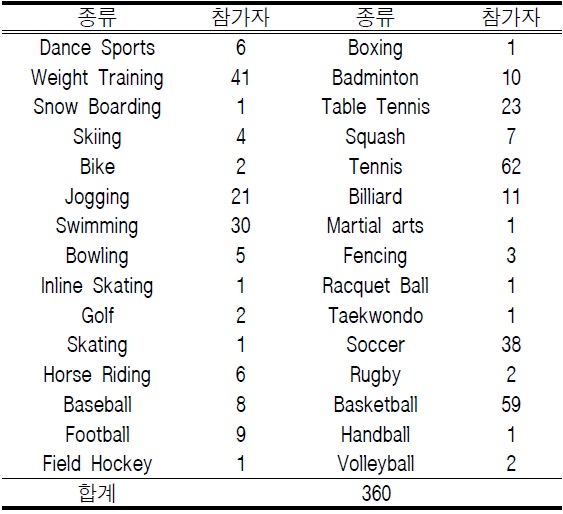
연구대상자의 신체적 여가활동 종류
Using SPSS 18.0 and Amos 18.0, the data was analyzed. Factor analysis was conducted using Maximum Likelihood estimation and Varimax factor rotation. Items not factorized (eigenvalue>1) were removed from data analysis. As a result, 14 of 24 leisure attitude items, four flow items, and six of eight enjoyment items were used for data analysis. For assessing cognitive LA, six items were selected, factor loadings ranging from .588 to .754 and α value .808. Examples are “Physical leisure activities increase people’s happiness” and “Physical leisure activities renew people’s energy.” For measuring affective LA, four items were selected with factor loadings from .544 to .813 and α value .792. Examples are “Physical leisure activities give people pleasure” and “Physical leisure activities are refreshing.” For measuring behavior LA, four items with factor loadings from .599 to .778 and α value .748 were selected. Examples are “I would attend a seminar or a class to be able to do physical leisure activities better” and “I give physical leisure activities high priority over other activities”. <Table 2> shows a summary of the factor analysis and item reliability analysis.
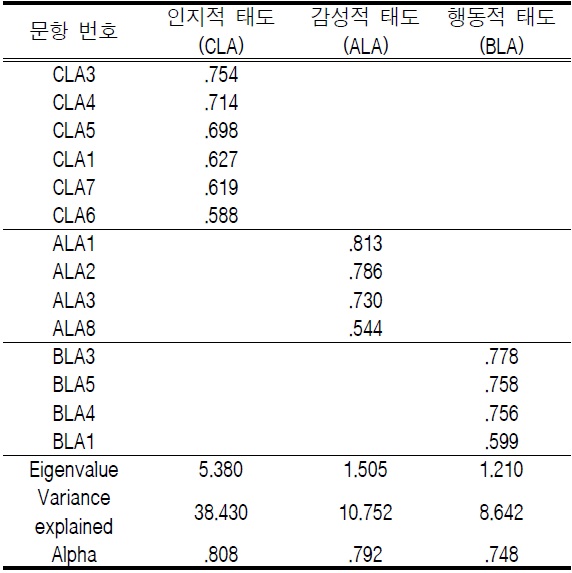
여가태도 탐색적 요인분석 결과
To measure flow, four items were used. Examples are “When I participate in this leisure activity, my thoughts and actions seem to flow together” and “When I participate in this leisure activity, I get so absorbed in it that I lose all sense of time.” Flow items had factor loadings ranging from .721 to .852 and α value .792, presented in <Table 3>.
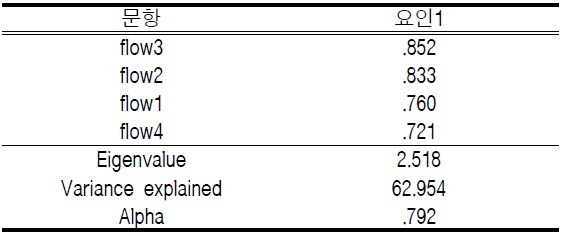
몰입 탐색적 요인분석 결과
To measure enjoyment, six items, four from nonachievement dimension and two from achievement dimension, were selected. Examples are “During the times when I most enjoy this activity, I usually experience that enjoyment through competing and improving my skills and performance”(the achievement dimension of enjoyment) and “Enjoyment from making new friends and fostering social competition”(the nonachievement dimension of enjoyment). Nonachievement enjoyment items had factor loadings from .720 to .860 and α value .811. Achievement enjoyment items had factor loadings from .871 to .875 and α value .710. <Table 4> shows a summary of the factor analysis. In addition to the six items, an item assessing a general level of enjoyment was included. The item was a 10 point likert scale and asked subjects about “On average, how do you rate your level of enjoyment from 1 to 10 scales.”
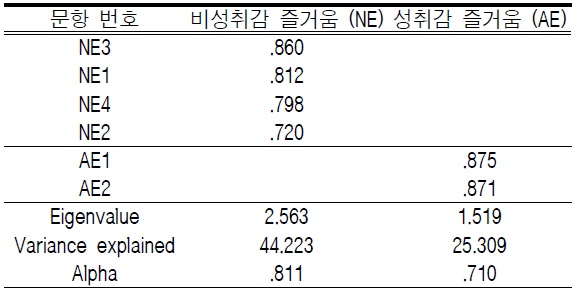
즐거움 탐색적 요인분석 결과
The relationships between LA, flow, and enjoyment were examined using bivariate correlation<Table 5> and multiple regression analysis, and a conceptual model in the order LA, enjoyment, and flow was examined using Structural Equation Modeling(SEM).
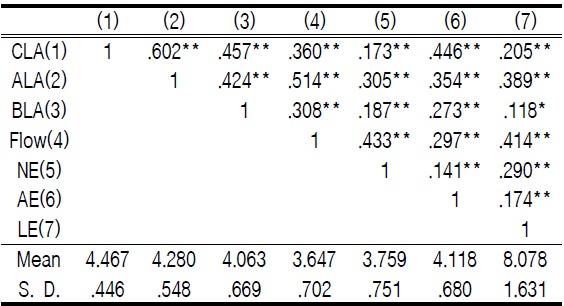
요인 간 상관관계 분석 결과
Affective LA significantly positively related to flow, achievement enjoyment, nonachievement enjoyment, and a general level of enjoyment. Cognitive LA positively related to achievement enjoyment. Behavioral LA showed no significant relationship to any subsets of enjoyment and flow. <Table 6> shows a summary of the multiple regression analysis. All the subsets of enjoyment showed a significant relationship to flow. <Table 7> shows a summary of the multiple regression analysis.
[표 6.] 여가태도, 즐거움, 몰입의 다중회귀분석 결과
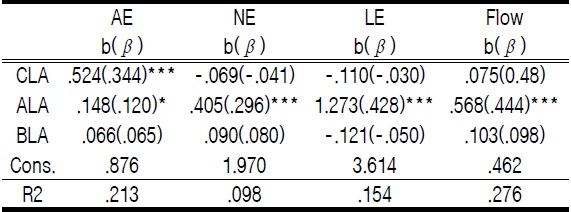
여가태도, 즐거움, 몰입의 다중회귀분석 결과

즐거움과 몰입의 다중회귀분석 결과
A conceptual model was examined using Structural Equation Modeling(SEM) with maximum likelihood estimation. Missing data were treated by pairwise exclusion. The numbers beside paths in <Figure 2> are standardized coefficient values, and rectangular boxes and ellipses represent observed variables and latent variables respectively. Only the statistically significant paths are presented. The dotted path from LA to flow shows a nonsignificant relationship. Overall fit indices for the models are summarized in <Table 8>. The column of A Good Fit Model in <Table 8> provides acceptable and mediocre index values. Although this study model did not meet the chi-square condition, this model could be deemed mediocre because it satisfied the relative chi-square index(χ²/df). Nonsignificant chi-square is one of the important overall fit indices. However, lately, relative chi-square is more often used because chi-square is found to be too sensitive to sample size. A relative chi-square value between 1 and 3 is an indication of an acceptable fit in general, but Wheaton, Muthen, Alwin, and Summers (1977) suggested that an acceptable ratio could be as high as 5.0. Values higher than .90 on IFI and CFI indicate a good fit. A RMSEA value between .08 to .10 provides a mediocre fit and below .08 shows a good fit(MacCallum, Browne, & Sugawara, 1996). This model showed acceptable and mediocre model fit indices, presented in <Table 8>.

측정모형의 적합도 검증
Findings indicated that having positive affective LA most contributes to experiencing flow and all the subsets of enjoyment. This engenders a thought that leisure practitioners and educators need to focus on cultivating young generation’s affection for PLA when they provide leisure services or leisure education. Given that current leisure education heavily emphasize an understanding of the benefits of PLA participation, this finding is informative for leisure educators such as physical education teachers in high school or middle school. This information is also useful for those who allocate limited resources for leisure services or education. For example, more aids need to be directed to leisure participants with strong cognitive LA and behavioral LA since they are less likely to experience enjoyment and flow without aids provided by leisure practitioners.
Cognitive LA showed a positive relationship to achievement enjoyment. This indicates that people with positive cognitive LA are likely to enjoy the situations where they are provided with learning opportunities and where they easily succeed their task because these experiences are closely associated with achievement enjoyment. In contrast, activities focusing on nonachievement enjoyment such as peer evaluations and social praises could be less effective.
A conceptual model in the order LA, enjoyment, and flow emerged, but this model needs to be further examined because some model fit indices are mediocre. Based on the emerged conceptual model, it can be proposed that people with positive LA(e.g., stronger belief that leisure activities give people pleasure) frequently experience enjoyment (e.g., I frequently experience enjoyment from the excitement of my current PLA and the thrill of competition.), and subsequently, this leads them to experience flow(e.g., I often become deeply engrossed in my physical leisure activity). In the conceptual model, LA does not show a direct path toward flow when enjoyment is placed as a mediating variable, indicating that the link between LA and flow is clearly mediated by enjoyment.
The reason is that Sobel(1986) proposed if a significant bivariate correlation between an independent variable and a dependent variable disappears after including mediation variables, the mediating variables fully mediate between the independent variable and the dependent variable. In this study, initial bivariate correlations between LA and flow were found, but in SEM, the relationships disappeared, indicating that LA influences flow through enjoyment. This finding highlights the importance of enjoyment in PLA contexts, and this becomes more obvious when the positive relationships from all the subsets of enjoyment to flow are accounted.
This study found leisure service providers need to assess clients LA so that they can provide individualized services. This will increase chances for leisure participants to experience enjoyment and subsequently to have flow experience. It is also a useful means of planning and designing an effective leisure program.
The significant connections between all the subsets of the enjoyment and flow indicate that enjoyment plays an important role in having flow in PLA contexts. It is, thus, necessary to cultivate a fun-oriented atmosphere when we design leisure program. It is also possible that there are more possible mediating variables, such as leisure involvement and leisure negotiation, mediating the relationship between LA and flow. Future research endeavors may be directed to find and examine those possible variables.
Current leisure education is overly purposed to make students know the importance of and the benefits of PLA(a cognitive side of leisure experiences). However, the findings of this study propose that it is necessary to lead students to develop and understand affective aspects of leisure experiences. However, detailed guidelines for this remains unanswered.
